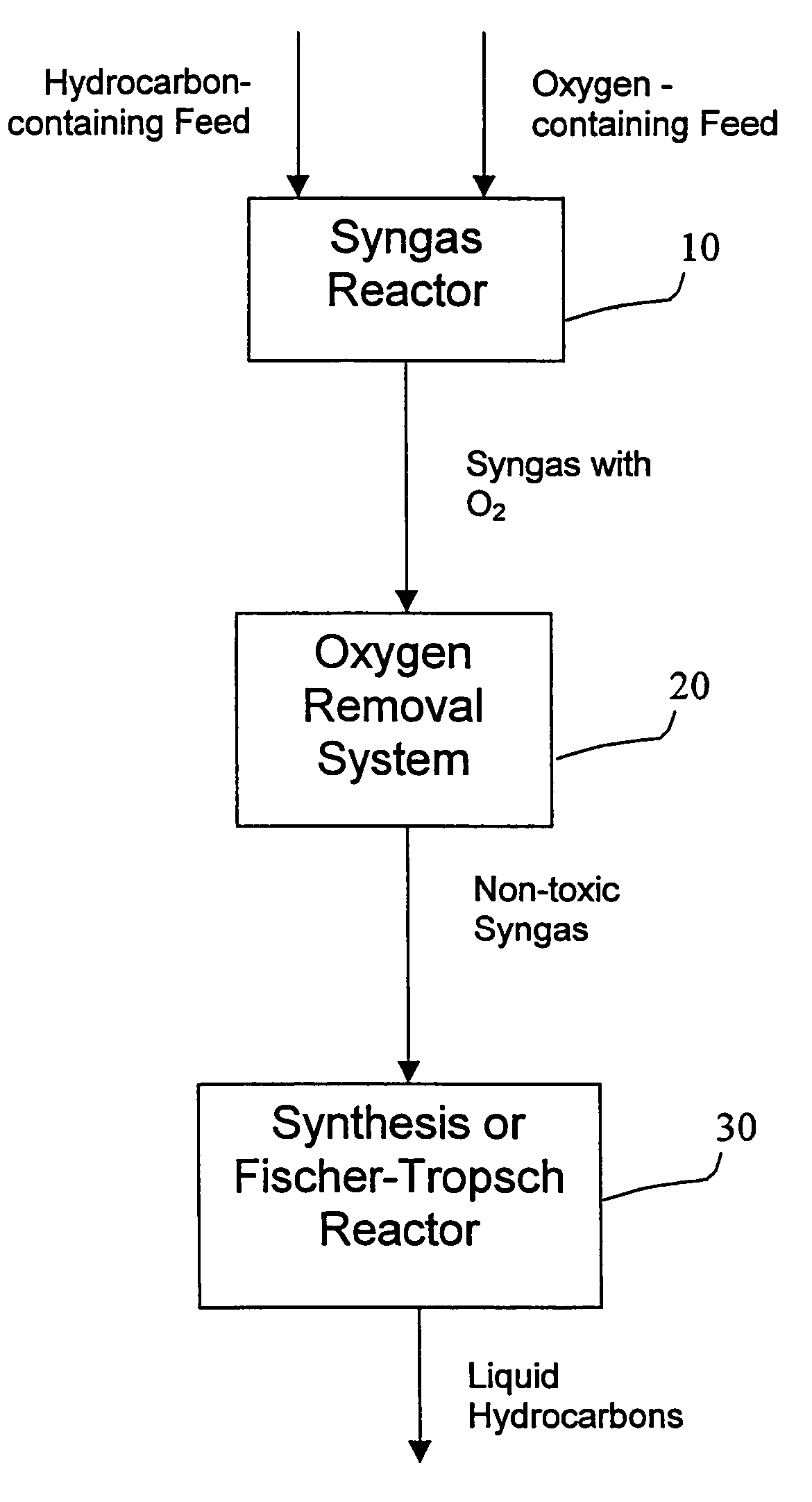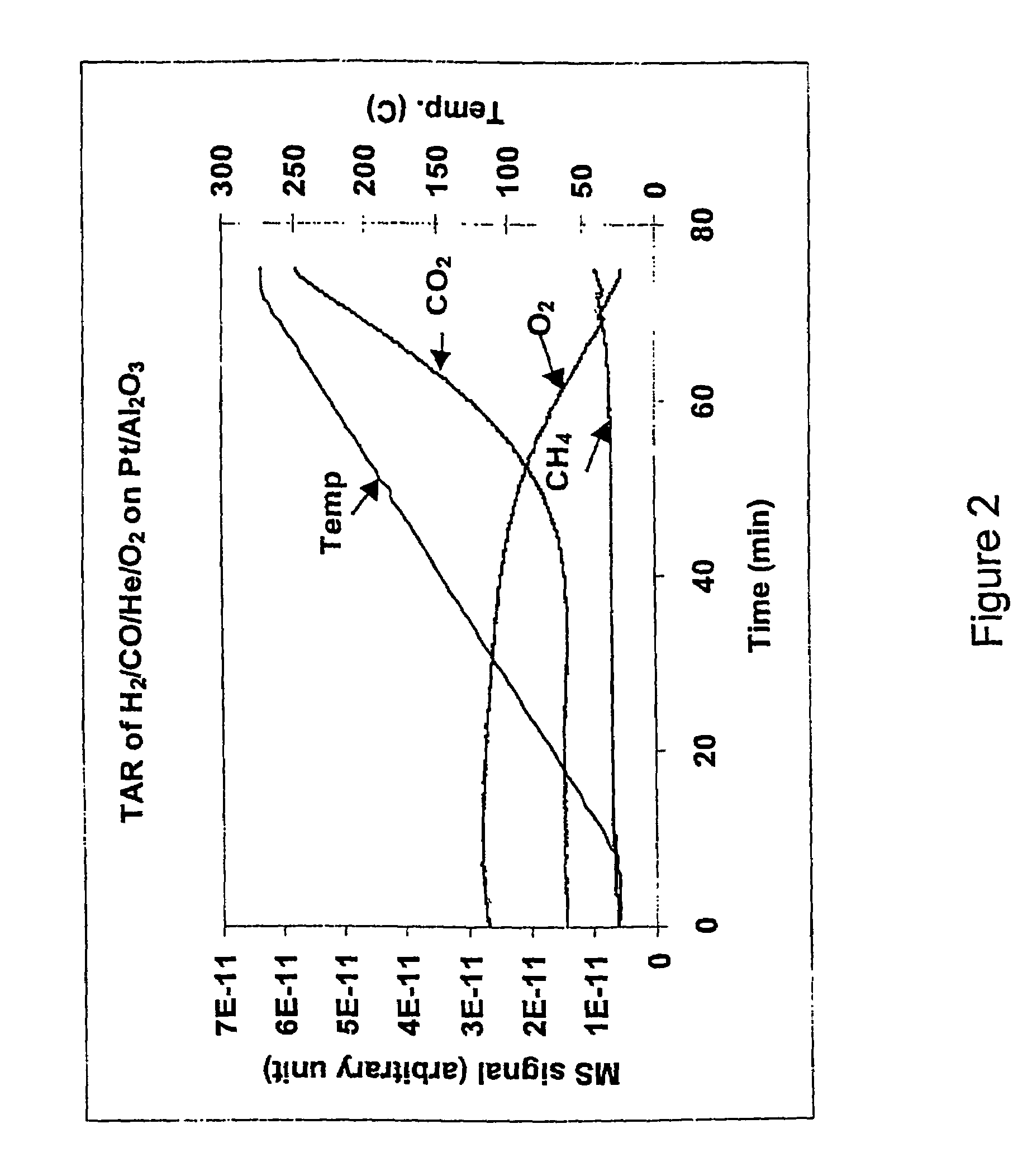Selective removal of oxygen from syngas
a technology of oxygen removal and syngas, which is applied in the preparation of oxygen-containing compounds, hydrogen separation using solid contact, oxygen/ozone/oxide/hydroxide, etc. it can solve the problems of large steam reforming plants that are not practical to set up at remote sites, the 3:1 ratio of hsub>2/sub>:co products is problematic, and the use of economic attractiveness
- Summary
- Abstract
- Description
- Claims
- Application Information
AI Technical Summary
Benefits of technology
Problems solved by technology
Method used
Image
Examples
example 1
Selective Catalytic Oxidation of Oxygen and Other Gases
[0063]Now referring to FIG. 1, a natural gas to liquid hydrocarbon flow diagram is shown to illustrate one general embodiment of the present invention. Hydrocarbon containing feed (such as methane, natural gas) and oxygen are used as reactants and passed through a syngas reactor 10 to produce a syngas product stream. Syngas is primarily hydrogen and carbon monoxide, however, unconverted oxygen, carbon dioxide, water and light hydrocarbons may also be present. In the preferred embodiment, the amount of unconverted oxygen is reduced from the syngas by passing it through an oxygen removal reactor 20 that promotes a reaction between carbon monoxide and oxygen. The oxygen concentration is thereby reduced to non-toxic levels. The syngas can then be used in a subsequent process such as a Fischer-Tropsch reactor 30. Alternatively, upstream of oxygen removal reactor 20, a recycling stream containing CO, hydrogen, light hydrocarbons etc. ...
example 2
Oxygen Selective Membrane with Catalyst Coating
[0091]Referring again to FIG. 1, in another preferred embodiment of the present invention, the amount of unconverted oxygen in the syngas exiting the syngas reactor 10 is lowered by passing the oxygen containing syngas stream through an oxygen removal reactor 20 that reduces oxygen levels via a structured reactor with an oxygen selective membrane and catalyst coating.
[0092]According to this preferred embodiment of the present invention, the oxygen removal reactor 20 reactor can be operated between 20° C. and 1000° C., preferably between 50° C. and 800° C., depending on the catalyst selected and the oxygen content in the feed syngas. As previously described in Example 1, during the transition of syngas from the syngas reactor 10 to the Fischer-Tropsch reactor 30, the syngas may go through a temperature window of 50° C. to 1500° C. Therefore, an oxygen-removal reactor 20 in accordance with Example 2 can be selectively placed within the tr...
example 3
Adsorption of Oxygen from Syngas
[0110]Referring again to FIG. 1, in another preferred embodiment, the amount of unconverted oxygen in the syngas is reduced by passing the syngas stream through an oxygen removal reactor 20 that reduces oxygen levels using adsorption or chemisorption techniques. The oxygen concentration is thereby reduced to non-toxic levels. The syngas can then be used in a subsequent process such as a Fischer-Tropsch reactor 30. It should be appreciated that variations may be made to this basic process flow diagram. For example, upstream of oxygen removal reactor 20, a recycling stream containing CO, hydrogen, light hydrocarbons etc. may be blended into the syngas stream.
[0111]Syngas reactor 10 can comprise any of the synthesis gas technology and / or methods known in the art. The hydrocarbon-containing feed is almost exclusively obtained as natural gas. However, the most important component is generally methane. Methane or other suitable hydrocarbon feedstocks (hydro...
PUM
| Property | Measurement | Unit |
|---|---|---|
| operative temperature | aaaaa | aaaaa |
| operative temperature | aaaaa | aaaaa |
| operative temperature | aaaaa | aaaaa |
Abstract
Description
Claims
Application Information
 Login to View More
Login to View More - R&D
- Intellectual Property
- Life Sciences
- Materials
- Tech Scout
- Unparalleled Data Quality
- Higher Quality Content
- 60% Fewer Hallucinations
Browse by: Latest US Patents, China's latest patents, Technical Efficacy Thesaurus, Application Domain, Technology Topic, Popular Technical Reports.
© 2025 PatSnap. All rights reserved.Legal|Privacy policy|Modern Slavery Act Transparency Statement|Sitemap|About US| Contact US: help@patsnap.com



